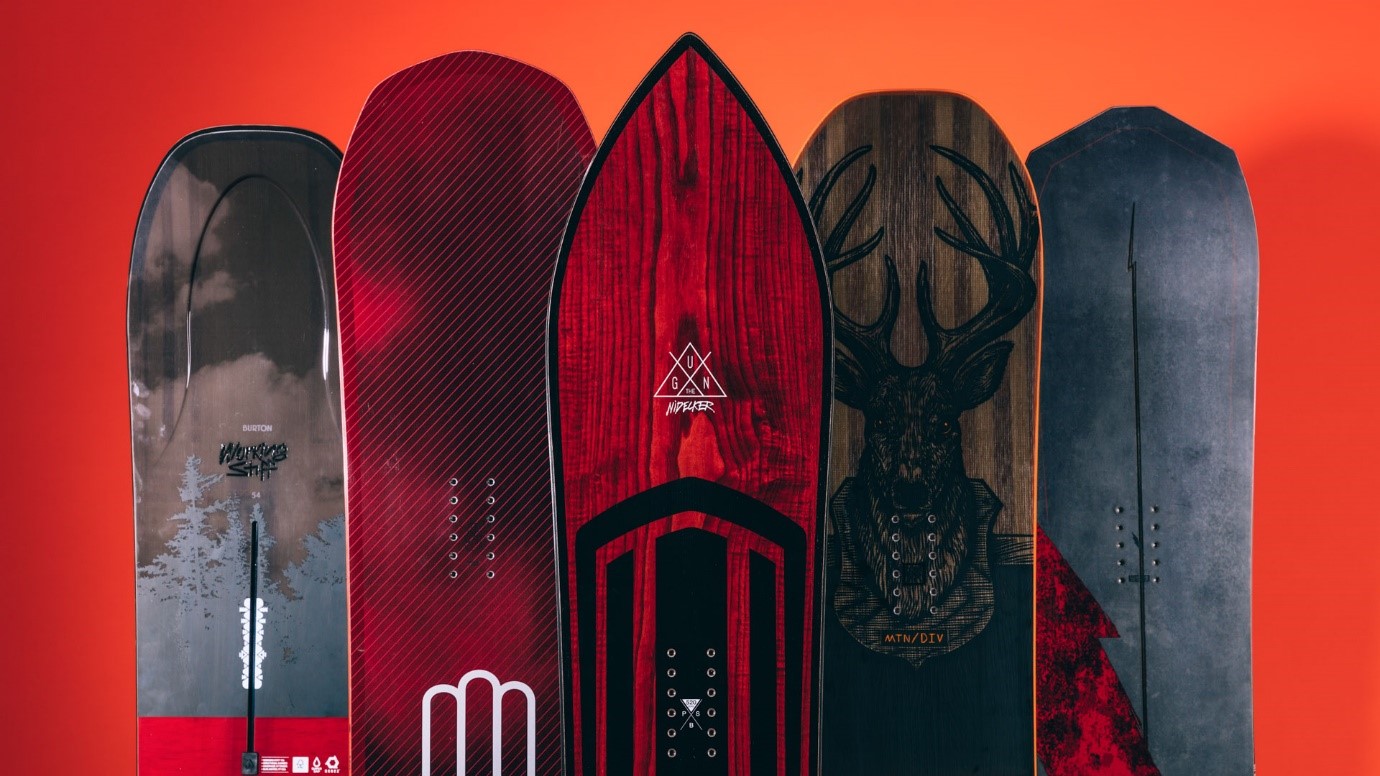You’ve booked on for your SnowSkool snowboard instructor course and you need to buy a new board to facilitate you to become a snowboard instructor! But where to start? Adam Sharps, CASI snowboard instructor and Head Rep for the SnowSkool Banff course, provides a few tips that will help get you the best board for you and your SnowSkool instructor course...
PROFILE
There is a lot of things to think about when it comes to picking the right snowboard and "profile" is the most important factor. There is a lot of fancy tech in new boards nowadays but you can usually put most boards into 4 categories:
Traditional Camber
This is where the middle of the board is raised off the ground. This gives the board more “pop”. Traditional camber is the perfect profile for carving, piste responsiveness and park riding

Reverse Camber (aka Rocker)
This is where the centre of the board, between your feet, touches the ground and the board rises to the tips. Reverse camber is the perfect profile for powder riding. The lifted tips will help you float! It is also helpful when learning to spin as the edges on a reverse camber board won’t catch as easily

Flat Camber
Completely flat camber isn’t a hugely popular profile. It puts together some pros of both traditional and reverse camber. A bit of a jack of all trades board so to speak. Provides a stable edge on piste and is easier to lift up in powder

Hybrid Camber
An extremely broad category. Hybrid cambered boards can be a very diverse mix of cambers, some common variations include:
- Traditional camber between your feet with reverse camber on the tip and tail
- Flat camber between your feet with reverse camber on tip and tail (Rocker/Flat)
- Reverse camber between your feet with traditional camber zones (humps) under your feet (Rocker/Camber)
All of these are designed to give a variety of different benefits when combining the different types of profiles.
MEASUREMENTS
There are two main measurements you’ll need to consider when picking up a snowboard. These are the length and the width and both will have a huge effect on your riding.
Length
This is usually, mistakenly, heavily linked with the height of the rider. Height does come into play but weight and how aggressive a rider you are would be considered more important. Most manufacturers will have their recommendations for each of their boards. A general rule of thumb is a board between your chin and your cheek bone, but take some advice from SnowSkool reps and SnowSkool snowboard instructors but, if you consider yourself a more aggressive rider and/or are a taller and heavier person, consider going up a size. Equally, consider downsizing if you feel you are less aggressive and/or shorter or lighter person.
Width
This is mainly to make sure you do not get any toe or heel drag when you are turning. Equally, you do not want to be trying to ride a super wide board with tiny feet. You will notice heel and toe drag almost instantly when you are snowboarding, this can be avoided by making sure your boots do not overhang either side by any more than 2 inches. If you have big feet, then you’ll need a wide board. Most manufacturers offer wide options on most of their snowboards. With the opposite problem of small feet, you can find boards that are built narrower.
SHAPE and FLEX
The last two factors when buying a board are the shape and the flex or stiffness.
Shape
There are a lot of fun and unique shapes coming out of the board manufacturers. From the square shaped Bataleon Wallie or the Lobster Eiki Pro to the almost completely circular Lib Tech Banana Hammock, there’s a huge variety. Most of them fall into one of two categories though:
- Directional: This is where the snowboard has an obvious front and back end. Usually found in powder boards so the raised front can keep the board floaty whilst the flatter and stiffer back of the board helps maintain control.
- Directional Twin: Tip and tail of the board look similar but vary slightly. Again, they have an intended front and back but are more forgiving when riding switch.
Twin – Both ends of the snowboard are identical. The most popularly found shape. Makes it much easier to ride switch.
Flex
This is how soft or hard the snowboard is. Softer boards are usually best in the park, help you pop and ollie easier as well as increase manoeuvrability for spins, butters and presses. Stiffer boards are ideal for helping you with stability, edging/carving and maintaining control at higher speeds.
SO WHAT'S BEST FOR SNOWSKOOL?
For a snowboard instructor course there is one board profile that comes out on top 99% of the time: Traditional Camber is the perfect profile for any of our courses. Becoming a Level 1 or 2 snowboard instructor will see you spending a lot of time on-piste, learning the basics before moving on to more advanced carving and edge control.
Taking traditional camber in mind, you’ll want to look at getting a true twin shaped board with mid-flex. This will mean you’ll have a board that’s great at sticking to the snow when you’re carving and is perfect for riding switch. We also advise taking the manufacturers recommendations when it comes to length of snowboard. You won’t want anything too big or too small as it’ll become harder to control.
And remember, as cool as some graphics may be, they are the least important thing when choosing a board. You’ll never see them when they’ve covered in snow anyway!
